Double Glazed Windows in Sydney
Nowadays, double glazing in Sydney is increasingly becoming more popular among homeowners and landlords for many reasons. They enhance the value of a home and add sustainability. Moreover, they increase security, sound insulation, and energy efficiency.
They bring the value of a home and its durability to an entirely new level. These windows use two sheets of glass rather than one. Inert gas or dehydrated air is used in the gap between the two panes. Double glazing may be done using different glass types and coatings that increase strength and energy efficiency.
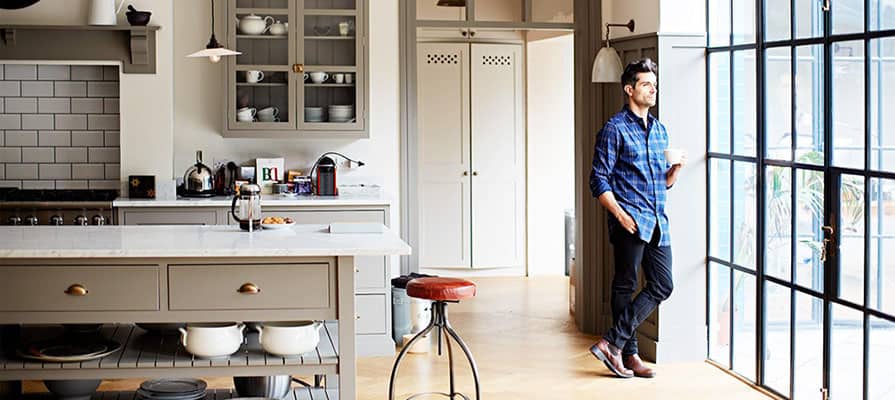
Windows that are made using a single pane contribute to more heat transfer such that a home which is well insulated will still lose significant amount of heat during winter and retain more heat during summer. Single paned windows are less effective as barriers to outdoor elements especially where frames are ill-fitted.
Single paned windows gain and lose heat just like the way a sieve allows water to pass through. Hence, they contribute to higher costs of cooling and heating the home. This means that they contribute to discomfort at home during cold and hot seasons.
Double glazing reduces heat loss from home by as high as 30% during winter. They also reduce the ability to gain heat by as much as 77% during summer.
Reducing cooling and heating costs is a great way of saving money. Around 40% of energy consumed in homes across Australia goes to cooling and heating the home.
Additionally, energy efficient windows reduce the carbon footprint of a home by reducing the overall emission of greenhouse gases. Landlords and homeowners gain a lot in terms of savings in cooling and heating costs by using double glazed glass windows.
For instance, installing these windows can save as much as $750 AUD annually in a bigger home. Smaller homes can save around $250 AUD annually when using these windows.
There are many glazing options available with the aim of insulating a window such that the need for heavy curtains, vertical blinds, or rollers is eliminated.
Basically, blinds, rollers, and curtains should have some pelmets installed at their tops to prevent connective currents from circulating as this may ruin the functionality of being energy efficient. Pelmets are usually thin cloth or wooden borders.
They are fixed at the top section of the window with the aim of covering the blinds or curtain fittings. You may also use roller shutters at the exterior side of a window to insulate it.
However, curtains, blinds, and roller shutters have a drawback of blocking visibility and incoming light. If you want to save energy and still see through the window, then consider using glass windows that are double glazed or coated with a special insulator.
What Are Double Glazed Windows
Double Glazing Explained
Double glazing involves using two glass panes with a narrow gap between them. This gap is filled with a gas or vacuumed and sealed off to enhance insulation. Inert gases that are used in the gap include argon, sulfur hexafluoride, krypton, or xenon.
These gases increase the insulation capability of the double glass panes. Triple pane or triple glazed windows are also becoming more popular for they provide more energy efficiency. The panes used range from 3mm – 10mm (1/8 inches – 3/8 inches) in width.
In some instances, the width can be thicker for enhanced security or acoustic attenuation. For such special purposes, the space can be around 6mm to 10mm in width.
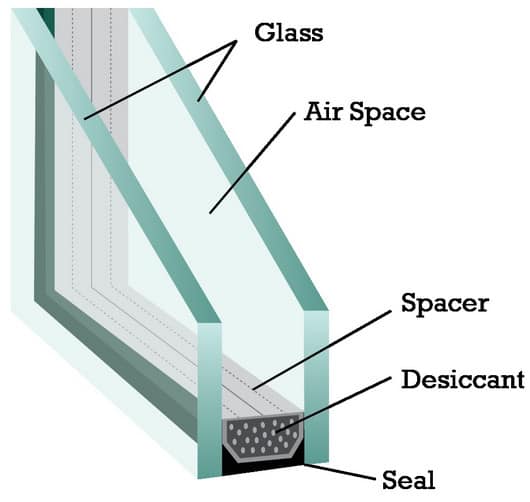
Different glass types may be used in double or triple glazing for enhanced functionality. For instance, laminated glass can be combined with tempered glass when glazing to increase energy efficiency and strength respectively.
A spacer is usually used between the two glass panes. The space was initially made using fiber or metal. However, manufacturers found that using a metallic spacer between the panes reduces the overall effectiveness of reducing heat transfer since metal is a good conductor of heat.
Metallic spacers also contributed to formation of water or ice between the two panes. Hence, many window manufacturers now prefer using spacers made of structural foam or aluminium.
Aluminium is a strong and flexible material but conducts more heat when compared to foam spacers. However, advances in technology have made it possible to develop aluminium spaces that have better capabilities of resisting heat transfer.
This is achieved by including thermal barriers in the aluminium spacer. However, foam spacers are still preferred by many manufacturers despite being more expensive than aluminium spacers since they minimize energy transfer better than aluminium ones.
Spacers usually have a desiccant that assists in eliminating any moisture that might be sandwiched between the panes. The desiccants soak moisture that might be present in the space or in the inert gas and this eliminates the problem of condensation between the panes especially during the cold winter season. In some situations, spacers are designed to reduce the entry of sound into a room.
Moreover, this glazing cuts down on ultraviolet rays by up to 75 percent. This assists in enhancing the lifespan of wood furniture, artwork, fabric, and carpets in a room. Cutting down on UV rays is also beneficial to the health of a person.
Most new homes are being constructed using these windows. You can also replace old single pane windows with double paned ones to enhance your home’s value and improve energy efficiency.
Why Use Windows That Are Double Glazed?
These windows are an ideal and smart choice for many reasons such as energy efficiency, sustainability, security, soundproofing and increasing the value of a property. Windows are a major point of heat gain or heat loss in any building.
Hence, upgrading them with energy efficient windows reduces energy use and this translates to huge savings on utility bills. Single pane windows that are made of untreated or pure glass let in more heat into a home than insulated walls during summer.
They also lose more heat from the home than insulated walls during winter. Gaining heat into a room during summer makes the interior living conditions unbearable and this demands air conditioning to make the air cooler.
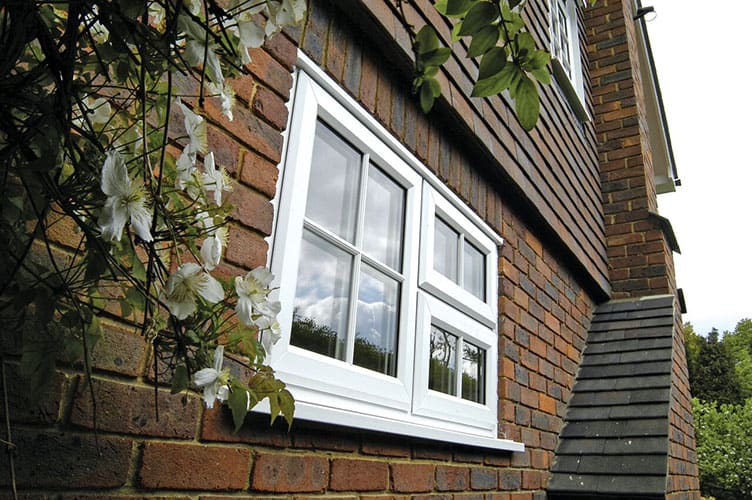
During winter, they allow heat loss from the room and this makes it colder such that constant heating is required to make the home warmer. This translates to more costs of heating and cooling a home when the windows used are not energy efficient.
The term used in describing the capability of a window, wall, or roofing to conduct heat is known as “U-value”. On the other hand, the term “R-value” is used to describe the heat resistance capability of the unit in question. Read more about the difference between U-value & R-value.
Optimally, the goal is having windows with low U-value whereas the R-value should be high. If you reside in an area with harsh and cold weather, then the most important aspect will be the window’s R-value.
For instance, a 3mm single pane would have a U-value of 5.9 while double panes measuring 3mm with a gap of 6mm between them would have a 3.1 U-value. The 3.1 rating is a better rating than 5.9 in terms of the U-value.
You may get other figures depending on thickness of the panes and other factors. However, follow this general range between the single and multiple glazing options.
For instance, if there is an average temperature of 15°C outside and the total single paned windows measure 70 square meters, then your property can lose energy at a rate of 6510 watts per night.
Installing double paned windows with a higher R-rating would reduce the energy loss by 50% and this means you would save a lot on heating costs. Although double glazing (also known as Insulated Glass Units) may cost a lot when installing, you will make more savings in the long run and this will be more than what you would spend when installing them.
For instance, if you spent $5,000 on installation, you can save around $1,000 annually. Hence, this is a worthy investment. Moreover, investing in double glazed windows in Australia is tax-free.
Thermal Performance
There are many several factors that are considered when assessing the exact impact that glazing your property will have on its thermal performance. The most crucial factors include your location’s weather conditions such as humidity, sunshine, temperature, wind conditions, and dew point.
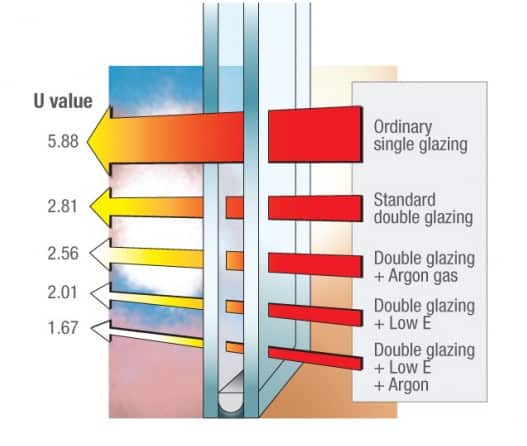
Source: Sustainable Homes
Other factors that impact on thermal performance include the design of the building, the ground layout, terrain positioning (whether facing downhill or uphill for example) and its orientation.
Construction materials, the building’s solid mass, and insulation also affect thermal performance. Once you consider these factors, then you have to take note of the possible improvements that may be done with glazing to enhance your windows’ thermal performance.
Passive Solar Design
A passive solar design style refers to constructing a property in a manner that the walls, doors, the floor, and windows will transfer heat from the sun and block it from penetrating into the house during summer and let it in during winter.
This design takes into account the climate, construction materials, and the location of the building to ensure energy consumption is kept at the lowest possible amount. The main aspect of a passive design is placing windows strategically to let the sun in during the cold season and block the sun during the hot season.
This design is cost effective when you want to get maximum thermal performance in your property. Basically, a building with a passive design lets in sunlight through the windows facing southwards.
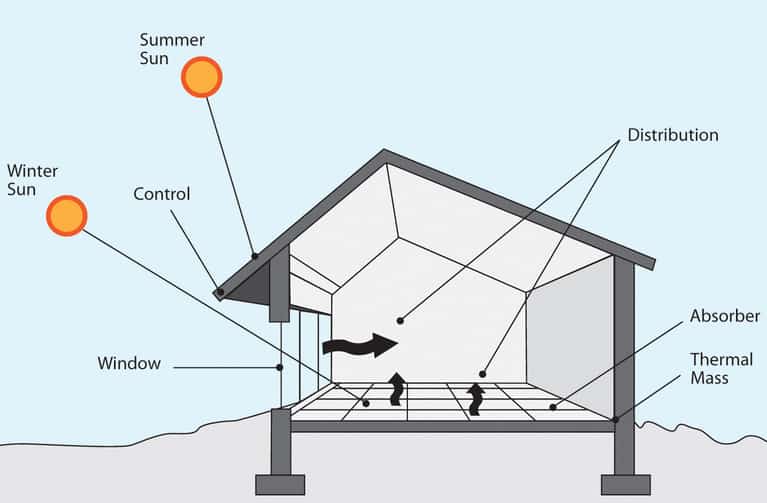
Source: Green Building Advisor
It also has materials for storing and retaining heat from the sun. The term thermal mass is used to refer to the mount of solar heat that can be stored by a material. The amount of heating needs that this functionality can supply to a home is known as passive fraction.
A home with a great passive fraction capability will offer excellent amount of daylight through a year. It will disburse heat during the cold season and offer enough ventilation during the hot season.
It is more effective to position doors and windows in an area of the property where there is maximum natural ventilation and seal off any openings in the areas where there may be unwanted draughts.
This is design is, however, suitable in some locations and not suitable in others. For instance, it may be more challenging to position windows in a way that they face winter sun in some buildings.
It is advisable to install windows with enhanced glazing capabilities to improve their overall thermal performance so as to capture maximum sunlight during winter. Hence, it is crucial to consider passive design when making a plan for your building and use double or even triple glazing for the windows.
Incorporating an effective passive design in your home will offer you massive payoffs in terms of reducing the energy costs and need for artificial heating in your home.
Choosing the Ideal Window
Ensure you go for the highest quality window to ensure optimal performance in thermal insulation. Consider factors such as its thermal gain coefficient and the window’s incidence angle.
The thermal gain of a window determines how easily it can convert sunlight into heat. It is basically the solar radiation amount that penetrates through the window.
It can be between 0-1 and it represents the solar radiation fraction that a window lets in. Some of the solar radiation is transferred whereas the rest is absorbed into the building.
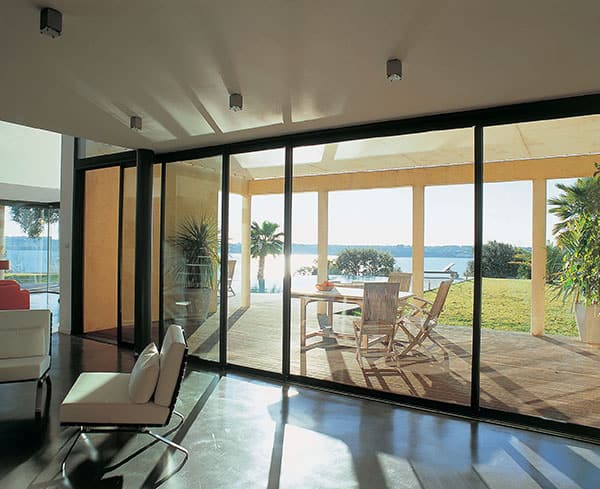
If the thermal gain coefficient is close to 1, then it means more heat is transmitted. For instance, if the thermal gain coefficient is 0.3, it means that exactly 30% of incoming sunlight is transmitted into the building.
If you have good knowledge about the thermal gain of a window, then you will be in a better position to choose the most appropriate windows for your building and where to install them.
The installation location depends on the terrain and climate of your building’s location. For instance, windows that have extremely high heat gain coefficient are ideal for colder areas to let it maximum sunlight during winter.
It’s also good to note that in areas with hotter climate where a lot of cooling is required, it is more ideal to use windows with lower heat gain to enhance the overall cooling effect. You might be interested in reading our blog about 25 things to know about windows.
Another factor that has a lot of influence on heat gain is the incidence angle, which is the angle at which sunlight hit a glass window. A higher angle of incidence means that more solar radiation will get reflected away rather than being transmitted into the house.
A window with high thermal gain might end being unsuitable depending on its incident angle. The incidence angle depends on various factors like the sun’s position, season, and weather.
Ensuring that sunlight bounces off and gets through the window as needed would guarantee you to achieve the heat repulsion and heat retention levels you require in your home.
Types of Window Glazing
There are many types of glazing products available in the market such that you can always get the best product for your home. The thickness of a glass window doesn’t have a huge impact on heat gain coefficient and U-value, but is determines the soundproofing ability and breakability.
Here are some of the most common glazing options available and some of their key advantages:
-
Low-Emissivity Type of Glass
This type of glass is also known as low-e type of glass. It is basically a type of glass that is coated using a special type of layer to let daylight into a room and limit heat from escaping from the room.
This assists in reducing heat transfer while still redirecting interior heat within the room rather than allowing it dissipate. If you replace non low-emissivity glass with those that have low-e coating, you will reduce the energy consumption in your home by around 50% and reduce heat loss through your windows by around 75%. During colder months, low-emissivity glass retains good amount of solar heat.

Source: Oridow.com
Since heat typically moves to a colder area, low-emissivity coating functions by repelling some heat rather than keeping it around the room. Using this type of glass in double glazed windows makes the exterior glass get less heat from the escaping heat.
The interior glass gains more heat than usual as a result of an increase in the retained heat. The end result is cutting down on cold air and condensation on the double paned window.
Therefore, low-emissivity glazing is worth considering since it stops heat loss such that a room remains warm during winter.
-
Toned Glass
Colored glass offers some difference in heat gain coefficient and visible transmittance. This won’t impact a lot on the U-value although it will depend on the color used for toning.
Grey and bronze colors reduce infrared radiation and visible right. Green or blue color allows in more radiation and visible light.
Toned glass is especially important for windows which get too much direct sunlight and you want to reduce the sunlight without having to block the outside view with curtains or shutters.
However, a key drawback that comes with this form of glass is allowing little light to pass through during dark winter months. Hence, they are not ideal where you want to enjoy a lot of sunlight indoors during winter.
This glass is very desirable when used in double paned windows. Super-toned panels are very effective as they absorb some solar heat and keep a room cooler during hot days. This glass also comes with the benefit of blocking out more UV radiation than what standard toned glass can block.
-
Laminated Glass
This type of glazing involves using a very thin plastic later between two glass panes. The main purpose of this layer, also known as the interlayer, is to enhance the strength of glass and prevent it from breaking into dangerous pieces.
The lamination layer holds the shards together in case the glass breaks. As such, another name used in place of laminated glass is safety glass. It is commonly used in side panels, glazed doors, shelving units, store windows, skylights, side panels, kitchen cabinets, bathroom shelving, and glass partitions.
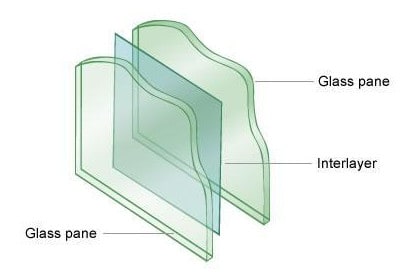
Source: Build.com.au
Laminated glass reduces noise, enhances security, reduces UV radiation, and its installation process is easy. Regular glass can shatter easily and the sharp shards pose a great danger.
However, laminated glass boasts of resisting impact and it is ideal for overhead glazing. This glass is also suitable in areas that may experience break-ins since it is resistant to smashing.
This glass also reduces noise from entering or leaving a room. It also reduces UV radiation that may enter a room. UV rays tend to fade carpets, artwork and furniture.
Hence, they reduce the lifespan of such household items. Laminated glass is applicable in almost any glass such as sheet glass, float glass, toughened glass, bent glass, fused type of glass, wired glass, glass, and patterned glass.
-
Secondary Glazing
You can also opt to go for secondary glazing instead of installing a brand new insulated glazing unit. This type of glazing involves adding a glass sheet or transparent acrylic on the interior side of the frame or a moveable window sash powered by a magnet system or housed within a secondary frame.
Although this glazing option does not offer an airtight space like in double glazing, the air pocket reduces U-value and air flow. Double glazed windows are more effective in reducing heat gain and heat loss than secondary glazing. However, secondary glazing is efficient in reducing energy transfer.
It is also considered more affordable than double paned windows since it is easy to install on existing windows, such that you will not have to install new windows.
This option is more efficient in reducing external noise than double paned glass windows since the space between the main glass and the secondary glass is wider.
You can install this type of glazing on your own, unlike in the double glazed option where you would have to hire a professional installer.
-
Films
You can also add an insulation film to an existing window or a double paned window to reduce heat gain. For instance, installing a cling film onto single paned windows can assist in reducing energy loss since it blocks energy transfer.
It also blocks draughts that may come through window frames that are poorly fitted. Adding insulation films is one of the most affordable substitutes for double pane windows.
Polythene films are also an ideal choice of glazing films. They are DIY friendly and they can be used on an existing window. This makes films an ideal choice for glazing in rental houses since you will not require permission from authorities or the property owner.
However, their major drawback is that you will be unable to open the window unless you remove the film. Hence, you will always have to remove the film whenever you want cool air to enter the space during a warm day.
Window Frames
Frames have a huge impact on a window’s thermal performance. The material of the frame and how properly it is fitted affects the overall performance of the window. An ideal frame is the one made from a high-performance and dependable material.
It is also crucial to read the product’s fine print and check its warranty since different companies often have different details about their window frames. Here are some of the most popular types of window frames:
-
Aluminium Frames
These window frames are strong, durable, and sleek. They do not fade under direct sunlight. They are free from the problems that face UPVC, composite, and wooden frames.
For instance, aluminium frames do not rot like the wooden ones. These frames may be finished using different anodized finishes and powder coating.
Nonetheless, these frames have some drawbacks. For instance, they are less energy efficient than UPVC, composite, and wooden frames. Aluminium is a good conductor of heat but does not excel at keeping the heat.
Hence, it lowers the overall insulation capabilities of an insulated window. These frames are relatively expensive.
-
Timber Frames
Choosing wooden frames is a tasteful and smart option. Wood has a natural and pleasing appearance, combined with substantial insulating capabilities. The most popular types of timber used in these frames are pine, oak, and spruce.
It is also good to check which type of timber has been sourced from a sustainable forest. Some of the main drawback of these frames are wearing out and rotting, especially during cold and rainy weather.
These frames also demand regular maintenance such as painting or applying varnish coating to reduce the impact of weather elements on the wood such as contracting and expanding when temperatures changes.
The pricing of these frames is mainly dependent on the type of wood and the size of window. For instance, hardwoods are more costly than softwoods.
-
Composite Frames
Composite frames are a great choice since they comprise of a combination of an exterior aluminium layer and an interior timber or UPVC layer. This combination provides long lasting frames that demand little maintenance. This also enhances the capability of retaining heat.
These frames were originally meant for use in areas with extremely cold weather since they lose minimal heat especially when used in multiple pane glazing options.
These frames have the naturally appealing look of wood and eliminate the drawbacks of contraction and swelling. The external layer of aluminium also assists by resisting moisture and harsh weather.
-
UPVC Frames
These frames are increasingly becoming more popular in Australia. They have been commonly used in North American and Europe for quite some years now. They are now becoming a more preferred choice over wooden frames.
However, they are limited in terms of color choices like you would get with coated aluminium frames. Nevertheless, a color foil may be fitted on the UPVC window frames to give them a preferred color. UPVC comes with the benefit of crafting to form airtight seals that improve insulation.
UPVC frames have reasonable costs and are lightweight and highly durable. Moreover, they can be installed on extra large windows. It is important to note that they are not sourced from renewable sources although they can be recycled.
They also tend to collect dirt inside. However they’re quite easy to maintain and clean. They’re an attractive choice of a frame material for windows. Frames made of fiberglass are also entering the window frames market. They are now being introduced as another window frame alternative in the Australian market.
Double Glazing Benefits | Advantages of Insulated Glass Units
They are many benefits offered by this form of glazing as outlined in this article. From enhancing comfort to reducing noise pollution and increasing energy efficiency, these windows are now becoming a more popular option for property owners.
They contribute to savings on utility bills and reduce greenhouse gas emission by reducing energy use. Hence, they are cost effective and environmentally conscious.
They also enhance the strength of doors and windows while still offering acoustic and thermal benefits that make the home a better place to live in no matter the weather condition outside.
They reduce the energy footprint of a home to an extent of raising the energy insulation rating of a property by as much as 50 percent.
This glazing option also comes with the benefit of reducing external noise pollution. This may be enhanced further by using glass with high-performance soundproofing properties.
These windows eliminate the use of shutters and curtains over the windows unless where they would still be necessary for privacy reasons. You will not have to use muggy coverings on your window. You will still enjoy viewing the beauty of the nature outside.
Double pane windows with their desiccants and spacer bar reduce the potential for mold formation and condensation even in areas that have constantly high moisture levels such as the bathroom.
This form of glazing comes with an airtight and dry sealing. For instance, double pane windows benefit from the airtight and dry seal since it reduces internal condensation. This also prevents wooden frames from rotting.
Australian glass standards have to be considered in double glazing. These standards include thickness of the panels, the ability of withstanding human impact and wind load. In some areas, it would be required to withstand bushfires of a certain level.
However, windows on most old homes may not meet these standards, but window glass replacement in Sydney would have to observe the set standards.
These windows also enhance the security of a property. For instance, toughened glass and laminated or safety glass are harder to break than regular glass. This ensures that the household is safer knowing that this glazing option adds an extra layer of security to the home.
Finally but not least, installing double glazed windows increases the value the property especially when you have plans of selling it in future. It can also increase the profitability of a rental property since its value is increased, meaning that more rent may be charged.
An older building may even look like new by replacing older single pane windows with double pane insulated windows. From this information, it is clear that installing double glazed glass windows is truly beneficial. For more information, feel free to contact our expert glaziers in Sydney today.
